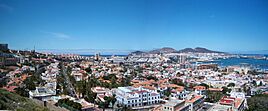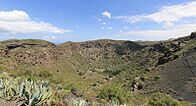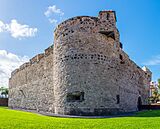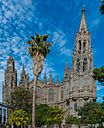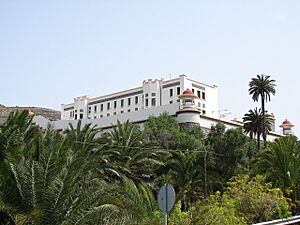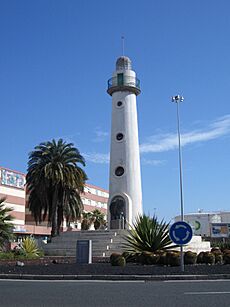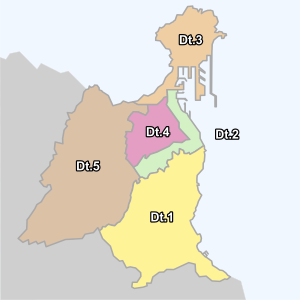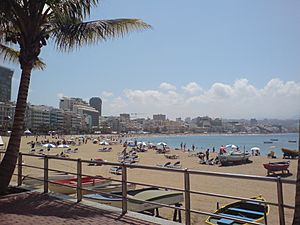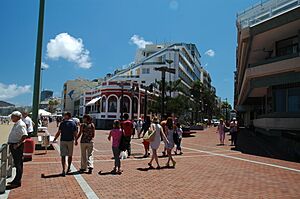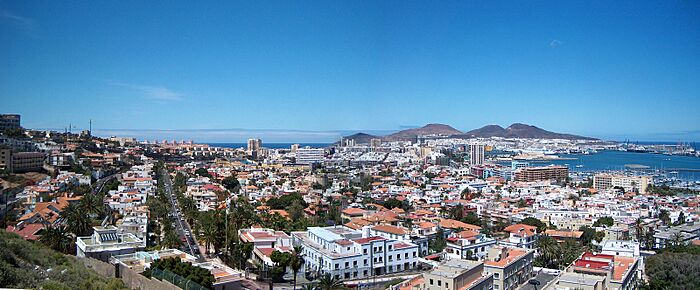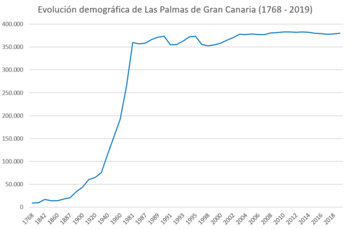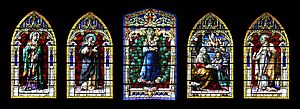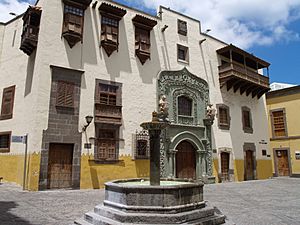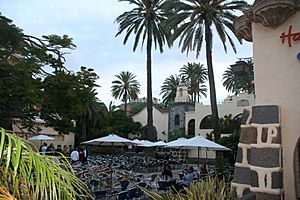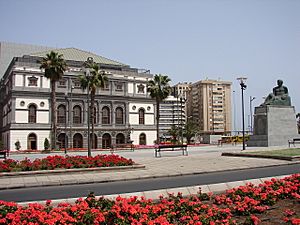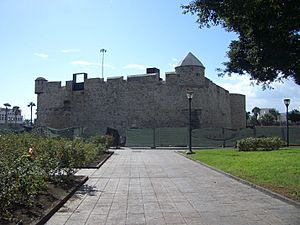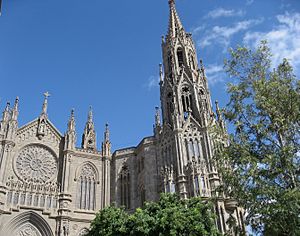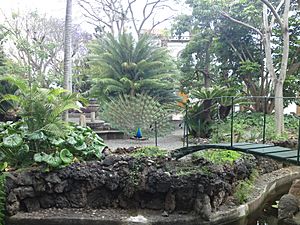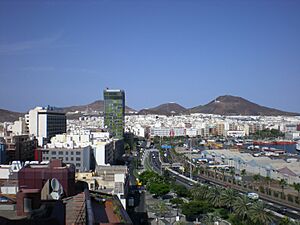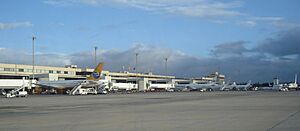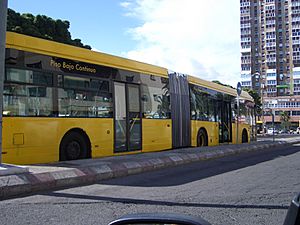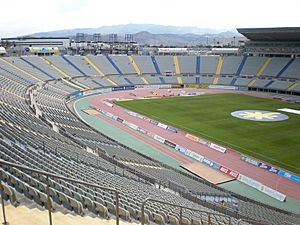Las Palmas facts for kids
Quick facts for kids
Las Palmas de Gran Canaria
|
|||
|---|---|---|---|
|
Panoramic view
Playa de Las Canteras
Colombus House
Castillo de la Luz
|
|||
|
|||
| Country | Spain | ||
| Autonomous community | Canary Islands | ||
| Province | Las Palmas | ||
| Island | Gran Canaria | ||
| Founded | 24 June 1478 | ||
| Area | |||
| • Municipality | 100.55 km2 (38.82 sq mi) | ||
| Elevation | 8 m (26 ft) | ||
| Highest elevation | 300 m (1,000 ft) | ||
| Lowest elevation | 8 m (26 ft) | ||
| Population
(2018)
|
|||
| • Municipality | 378,517 | ||
| • Density | 3,764.47/km2 (9,749.9/sq mi) | ||
| • Urban | 635,000 | ||
| Demonym(s) | palmense (es) | ||
| GDP | |||
| • Metro | €14.822 billion (2020) | ||
| Time zone | UTC+0 (WET) | ||
| • Summer (DST) | UTC+1 (WEST) | ||
| Postal code |
35001-35020
|
||
| Language(s) | Spanish | ||
Las Palmas (officially Las Palmas de Gran Canaria) is a Spanish city. It is the capital of Gran Canaria island, located in the Canary Islands in the Atlantic Ocean.
It shares the title of capital city of the Canary Islands with Santa Cruz de Tenerife. Las Palmas is the most populated city in the Canary Islands. It is also the ninth-largest city in Spain, with about 381,223 people living there in 2020.
Las Palmas is on the northeastern part of Gran Canaria island. It is about 150 kilometers (93 miles) west of the Moroccan coast. The city has a hot desert climate, but the cool Canary Current in the ocean helps keep temperatures mild all year. The average yearly temperature is 21.2°C (70.2°F).
The city was founded on June 24, 1478. It was considered the main capital of the Canary Islands until the 1600s. Today, it is home to important government offices for the Canary Islands.
Contents
- History of Las Palmas
- City Districts
- Geography and Beaches
- Population and People
- Education in Las Palmas
- Culture and Arts
- Parks and Squares
- Interesting Architecture and Sites
- Places of Worship
- Transportation in Las Palmas
- Sports in Las Palmas
- Twin Towns and Sister Cities
- Famous People from Las Palmas
- Images for kids
- See also
History of Las Palmas
The city was founded by Juan Rejón on June 24, 1478. He named it "Real de Las Palmas." Rejón led the army from the Kingdom of Castile that came to the island. They fought against the local people.
The war started at the Guiniguada ravine. Rejón and his 30 soldiers set up camp there. This area is now known as the Vegueta district.
The fighting lasted for five years. Many lives were lost, especially among the native people. They did not have enough ways to defend themselves against the armies sent by the Catholic monarchs (the rulers of Spain). However, they fought bravely. The conquest ended in 1483. The island then became part of the Crown of Castile.
On November 20, 1485, the main church office (diocese) moved to Las Palmas. The city grew in importance. It became home to the Bishopric of the Canary Islands and the first Court of the Holy Inquisition. It also housed the Royal Court and the leaders (Captains General) of the Canary Islands. This meant Las Palmas was seen as the capital for a long time.
In 1492, Christopher Columbus stopped in the port of Las Palmas. He needed to fix his ship, the Pinta, on his first trip to the Americas. He also stopped there on his way back to Spain. The Colón House (Columbus House) is a museum in the Vegueta district. It is named after him.
In 1595, Francis Drake tried to attack the town. This led to the Battle of Las Palmas. In 1599, a Dutch attack caused some damage to the town, but the attackers were driven away.
Las Palmas' seaport, Puerto de la Luz (La Luz Port), started being built in 1883. This port helped the city grow and become more modern. The port became even more important when the Suez Canal was closed during the Suez Crisis. Many workers from other countries moved to the city during this time.
In 1927, the Canary Islands were divided into two provinces. Las Palmas de Gran Canaria became the capital of one of these provinces. This province included the islands of Gran Canaria, Lanzarote, and Fuerteventura.
Las Palmas is a sister city to San Antonio, Texas, in the United States. San Antonio was founded in 1718 by about 25 people from the Canary Islands.
City Districts
Las Palmas is split into five main areas called administrative districts. These districts are then divided into smaller parts. These smaller parts do not always match the older, traditional neighborhoods.
| No | District | Population |
|---|---|---|
| 1 | Vegueta, Cono Sur y Tafira | 73,243 |
| 2 | Centro | 88,546 |
| 3 | La Isleta-Puerto-Canteras | 71,412 |
| 4 | Ciudad Alta | 101,684 |
| 5 | Tamaraceite-San Lorenzo | 39,191 |
Geography and Beaches
The city has four main beaches. These are Las Canteras, Las Alcaravaneras, La Laja, and El Confital.
- Las Canteras Beach is the biggest beach in the city. Many locals and tourists visit it all year. The beach is on the west side of the Guanarteme isthmus. An isthmus is a narrow strip of land connecting two larger land areas. This isthmus links the La Isleta peninsula to the rest of Gran Canaria island. The beach is 3,100 meters (about 1.9 miles) long. A natural barrier of coral sandstone, called "the bar," protects much of the beach from ocean waves. You can easily swim to this barrier from the shore. The beach has received a special environmental award (ISO 14001 certification). A wide walking path, the Paseo de Las Canteras, runs along the beach.
- Las Alcaravaneras Beach is on the other side of the Guanarteme isthmus. It stretches for over 800 meters (half a mile) with fine golden sand. A promenade (walking path) runs along this beach. It connects to other beaches further south. The calm waters here are great for water sports like sailing and canoeing. The beach also has areas for sports like beach volleyball and basketball.
- La Laja Beach has fine gray sand. It is about 1200 meters (0.75 miles) long. The waves here are now safer because a dam was built in the 1990s. This beach is popular with surfers because of its strong waves. Boat races also start here every weekend from April to October.
- Confital Beach is southwest of the La Isleta peninsula. It is part of the same large bay as Las Canteras Beach. Confital Beach is narrower and has more volcanic rock than sand. It has comfortable walking paths and flat stone areas for relaxing. Surfing is a major activity here. Many surfers consider the waves at Confital to be among the best in Europe. Professional surfing competitions are held here each year.
Climate and Weather
Las Palmas has a subtropical desert climate. This means it has warm, dry summers and mild winters. The average yearly temperature is 21.2°C (70.2°F). During the day, the temperature is usually around 28°C (82°F). At night, it is around 18°C (64°F).
In January, the coldest month, daytime temperatures are typically 19 to 23°C (66 to 73°F). Nighttime temperatures are around 15 to 16°C (59 to 61°F). The average sea temperature in January is 20°C (68°F).
In August and September, the warmest months, daytime temperatures are usually 27 to 30°C (81 to 86°F). Nighttime temperatures are above 21°C (70°F). The average sea temperature is 23°C (73°F). Temperatures do not change much throughout the year.
The highest temperature ever recorded was 44.2°C (111.6°F). The lowest was 9.4°C (48.9°F). Las Palmas city has never had snow or sleet.
The air usually has about 66% humidity. The city gets over 2,800 hours of sunshine each year. It only rains about 22 days a year. The total rainfall is about 151 millimeters (5.9 inches) per year.
| Climate data for Las Palmas de Gran Canaria | |||||||||||||
|---|---|---|---|---|---|---|---|---|---|---|---|---|---|
| Month | Jan | Feb | Mar | Apr | May | Jun | Jul | Aug | Sep | Oct | Nov | Dec | Year |
| Average sea temperature °C (°F) | 20.0 (68.0) |
19.1 (66.4) |
19.1 (66.4) |
19.3 (66.7) |
20.0 (68.0) |
21.0 (69.8) |
21.8 (71.2) |
22.5 (72.5) |
23.4 (74.1) |
23.4 (74.1) |
22.1 (71.8) |
20.5 (68.9) |
21 (69.8) |
| Mean daily daylight hours | 11.0 | 11.0 | 12.0 | 13.0 | 14.0 | 14.0 | 14.0 | 13.0 | 12.0 | 11.0 | 11.0 | 10.0 | 12.2 |
| Average Ultraviolet index | 4 | 6 | 8 | 9 | 10 | 11 | 11 | 11 | 9 | 7 | 5 | 4 | 7.9 |
| Source #1: seatemperature.org | |||||||||||||
| Source #2: Weather Atlas | |||||||||||||
Population and People
As of 2008, almost half (45.9%) of the people on Gran Canaria island live in Las Palmas. This is also 18.35% of all the people in the Canary Islands. A study showed that people in Las Palmas de Gran Canaria live for about 80.9 years on average.
Throughout history, many people have moved to Las Palmas from mainland Spain and other countries. Most people in the city are Spanish. However, there are also large communities from North Africa, sub-Saharan Africa, and Latin America. The number of people from Venezuela is growing fast. There are also older communities like people from India (Sindhi) and Korea, and a growing Chinese population.
Near the city's port, there is a street with many Korean businesses. This area is sometimes called the city's Koreatown. It serves Korean sailors who visit the island. They sometimes call Las Palmas the "Second Busan" after a port city in South Korea.
Most native Canarians are a mix of different groups. These include the original people of the Canary Islands (called guanches). They also include the Spanish conquistadores (conquerors) and later European settlers. These settlers came mainly from Spain, Portugal, Flanders, France, Italy, Germany, and Britain.
| Year | Population | Density |
|---|---|---|
| 1991 | 354,887 | 3,529.46/km2 |
| 1996 | 355,563 | 3,536.18/km2 |
| 2002 | 370,649 | 3,686.22/km2 |
| 2004 | 376,953 | 3,748.92/km2 |
| 2007 | 377,203 | 3,751.40/km2 |
| 2008 | 381,123 | 3,790.38/km2 |
| 2010 | 383,308 | |
| 2012 | 382,296 | |
| 2014 | 382,283 | |
| 2016 | 378,998 | |
| 2018 | 378,517 | |
| 2020 | 381,223 | 3,755.84/km2 |
Education in Las Palmas
Las Palmas is home to the University of Las Palmas de Gran Canaria. This university was founded in 1989.
The city also has many state and public schools for younger students.
There are several international schools in the area:
- Deutsche Schule Las Palmas (German School)
- The British School of Gran Canaria (Tafira School is within the city)
- The American School of Las Palmas
- Lycée Français René-Verneau (French international school, located in Telde)
- Canterbury School of Gran Canaria (British international school)
Culture and Arts
Las Palmas offers many cultural events. These include theater, cinema, opera, concerts, art shows, and dance performances. The city hosts the Canary Islands Music Festival and the International Film Festival. The main city festival, "Fiestas de San Juan," celebrates the city's founding in June. The Carnival of Las Palmas de Gran Canaria is a big draw for tourists. The historic areas of Vegueta and Triana are being considered for UNESCO World Heritage Sites status.
Museums and Theatres
- The Museo Canario is in the historic Vegueta district. It opened in 1879. It has a valuable collection of old Canary Islands objects. It also has a large library with many books about the Canary Islands.
- The Casa Museo de Colón (Columbus House Museum) focuses on the history of the Canary Islands and their connection to America. It has 13 permanent exhibits. The museum is made up of several old houses. One of these houses was visited by Christopher Columbus in 1492.
- The Casa Museo Pérez Galdós is in the Triana neighborhood. It is the birthplace of the famous writer Benito Pérez Galdós. The museum has many of his personal items and books.
- The Museo Néstor is in the Garden City neighborhood. It is dedicated to the artist Néstor Martín-Fernández de la Torre. The museum opened in 1956. It has 10 exhibition rooms.
- The Elder Museum of Science and Technology is an interactive museum. It helps people learn about science and technology. It has 4,500 square meters (about 48,400 sq ft) of exhibits.

- The Atlantic Center of Modern Art (CAAM) opened in 1989. It is an important place for art in the Canary Islands. It shows art from the islands to the rest of the world. It has both permanent and temporary art shows.
- The Teatro Pérez Galdós (Pérez Galdós Theatre) was first designed in 1867. It was largely rebuilt after a fire in 1928. It was named after the Canarian writer Benito Pérez Galdós. The theatre reopened in 2007 after more renovations.
- The Cuyás Theater was built on the site of an old cinema. Its main hall can hold 940 people. It also has a large outdoor area for events.
Libraries and Events
The city has 11 public libraries. There are also three special libraries:
- The Library Island can hold 500 people. It has many computer connections and internet access points.
- La Biblioteca Simón Benitez Padilla focuses on geology, biology, and ecology.
- The Archives Joaquín Blanco holds 160 years of the city's history.
There are many cultural events in Las Palmas:
- Festival of Theater and Dance
- Festival Internacional de Cine de Las Palmas de Gran Canaria (International Film Festival)
- Canary Islands Music Festival
- Jazz Festival
- Carnival of Las Palmas de Gran Canaria
- Founding Celebrations
- WOMAD Las Palmas de Gran Canaria (World of Music Arts and Dance)
- Opera Festival
- Fantastic and Terror Film Festival
Parks and Squares
Las Palmas has many beautiful parks and squares where people can relax and enjoy the outdoors. Some of the well-known ones include:
- Avenida Marítima
- Avenida Mésa y López
- El Confital
- Fuente Luminosa
- Parque de la Mayordomía
- Parque de Santa Catalina
- Parque Doramas
- Parque Juan Pablo II
- Parque de San Telmo
- Plaza de España
- Plaza de La Feria
- Plaza de Las Ranas
- Plaza Santa Ana
- Triana
Interesting Architecture and Sites

- The Bandama Caldera is a natural monument. A caldera is a large bowl-shaped hollow that forms after a volcano erupts and collapses. This caldera is about 1,000 meters (3,280 feet) wide and 200 meters (656 feet) deep. You can walk to the bottom in about half an hour. The area has volcanic ash and unique plants from the Canary Islands.
- There are many old archaeological sites in Santa Brígida. These include caves carved into rock and old storage areas used by the native Canarians. The Cueva de los Canarios (Cave of the Canarians) has ancient writings (Libyco-Berber inscriptions) from the Guanches, the original people of the island.
- The Church of San Juan Bautista in Arucas is sometimes called the Catedral de Arucas because of its large size. It was built using local stone starting in 1909. It has beautiful stained glass windows and carvings.
- The Jardín de la Marquesa de Arucas is a lovely botanical garden in Arucas.
- The Iglesia de San Juan Bautista de Telde is an important church in Telde. It was founded in 1483. Inside, you can see a statue of Christ made from corn dough by Mexican Indians. There is also a Flemish Gothic altar from before 1516.
- Telde has many archaeological sites. These include the coastal town of Tufia and the Four Doors cave site, Telde. This large cave has four entrances and overlooks the plain. There are also caves that were once a troglodyte village (a village where people lived in caves). The impressive Necropolis of Jinámar has over 500 ancient tombs.
- The Basílica de Nuestra Señora del Pino in Teror dates from 1760.
- The Palacete Rodriguez Quegles is a beautiful mansion from the early 1900s. It is now used for art shows and cultural events.
Places of Worship
In Las Palmas, most places of worship are Christian churches. These include churches from the Catholic Church and various Protestant churches. There are also Muslim mosques in the city.
Transportation in Las Palmas
Roads and Highways
The city's roads can be busy, especially on weekdays. The street layout is not always straight, which can be confusing. However, there are no toll roads. Main roads and important areas are well-marked.
Las Palmas is the center for the island's highway system. The city is connected by three main highways:
- The GC-1 goes south to Puerto de Mogán. It is the fastest way to travel from the north to the south of the island. It runs along the eastern and southern coasts. This highway connects the Gran Canaria Airport to major cities and resorts like Maspalomas.
- The GC-2 (North Highway) connects Las Palmas with the small northern village of Agaete. This highway runs along the beaches and coastline for part of its route.
- The GC-3 acts as a city bypass, connecting the other two highways.
Airport
Las Palmas is served by Gran Canaria Airport. It is also called Las Palmas Airport (LPA).
The airport is on the eastern part of the island, about 18 kilometers (11 miles) from the city center. In 2008, over 10 million passengers used the airport. It is the fourth busiest airport in Spain. It is also the only airport on the Canary Islands with two runways. This means it can handle many planes landing and taking off each hour. The long runways made it a possible landing site for the NASA Space Shuttle. This airport is also a base for airlines that fly between the Canary Islands.
Seaport
Puerto de Las Palmas (Las Palmas Port), also known as Puerto de la Luz, is a major port. It is used for fishing, trade, passengers, and sports. For five centuries, it has been a traditional stop for ships crossing the Middle Atlantic. The Port of Las Palmas is one of the most important ports in Spain. It is also the main port in the West Africa region. It acts as a connection point between Europe, Africa, and America. In 2007, about 11,262 ships visited the port. It also welcomed over 900,000 cruise passengers. The port is among the top 15 ports in Europe for cargo containers (TEU).
The Port of Las Palmas is the main fishing base in the Mid-Atlantic. It handles over 4,500 fishing ship stops each year. It processes about 400,000 tons of frozen fish. The port has special refrigerated areas for processing and storing fish.
The Muelle Deportivo is the main marina for yachts. It is across from the commercial port and can hold 1250 boats. It is a popular starting point for the Atlantic Rally for Cruisers (ARC and ARC+). In this event, up to 300 yachts sail from Las Palmas to the Caribbean in November.
- In the port of Las Palmas
Bus System
Las Palmas has a good bus system run by the company Guaguas Municipales. They offer 40 bus routes within the city. The main bus lines run very often, every 3 to 15 minutes during the day. Some lines also run at night. The bright yellow buses are simply called 'guaguas'.
You can buy a reusable plastic card called a 'bono de diez' to pay for 10 rides. This card can be refilled at bus stations and machines.
Another bus company, Global, runs inter-city buses. These blue buses connect Las Palmas to other towns on the island.
There is also a Guagua Turística (Tourist Bus). This bus takes visitors to the most interesting places in the city with a guide.
Sports in Las Palmas
Las Palmas is home to three major professional sports teams:
- UD Las Palmas is a football (soccer) club. They play in Spain's top league, La Liga. Their home games are at Estadio de Gran Canaria, which can hold 32,665 fans.
- CB Gran Canaria is a basketball club. They play in Spain's top basketball league, Liga ACB. Their games are at the Palacio de Deportes de Las Palmas.
- La Caja de Canarias (Club Voleibol J.A.V. Olímpico) is a women's volleyball club.
Las Palmas was one of the host cities for the 2014 FIBA World Championship in basketball. Matches were played at the new Gran Canaria Arena.
Many outdoor sports are popular in the city. These include surfing, windsurfing, kitesurfing, swimming, diving, and paragliding. Running, cycling, rowing, tennis, and golf are also popular. The Real Club De Golf De Las Palmas is the oldest golf club in Spain, opened in 1891.
Twin Towns and Sister Cities
Las Palmas is twinned with these cities:
 Garachico, Spain
Garachico, Spain San Antonio, United States
San Antonio, United States Guanajuato, Mexico
Guanajuato, Mexico Nouadhibou, Mauritania
Nouadhibou, Mauritania
The city has also agreed to be twinned with these cities, though it might not be official yet:
 Rabat, Morocco
Rabat, Morocco Ekaterinburg, Russia
Ekaterinburg, Russia Praia, Cape Verde
Praia, Cape Verde Vigo, Spain
Vigo, Spain Gdańsk, Poland
Gdańsk, Poland Genoa, Italy
Genoa, Italy Martinsicuro, Italy
Martinsicuro, Italy Jalisco, Mexico
Jalisco, Mexico Xiamen, China
Xiamen, China
Famous People from Las Palmas

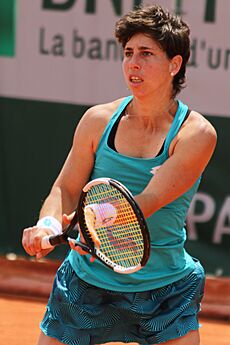
Many notable people were born or lived in Las Palmas:
- Santi Aldama (born 2001), professional basketball player
- Alfredo Kraus (1927–1999), a famous opera singer
- Javier Bardem (born 1969), actor
- Benito Pérez Galdós (1843–1920), a well-known writer
- David Silva (born 1986), a famous football player
- Carla Suárez Navarro (born 1988), tennis player
- Pinito del Oro (1930–2017), a famous trapeze artist
- Juan Negrín (1892–1956), a politician who was President of the Spanish Republican Government
- Antonia San Juan (born 1961), actress and director
- Isabel Torres (1969–2022), TV presenter and actress
Images for kids
See also
 In Spanish: Las Palmas de Gran Canaria para niños
In Spanish: Las Palmas de Gran Canaria para niños


